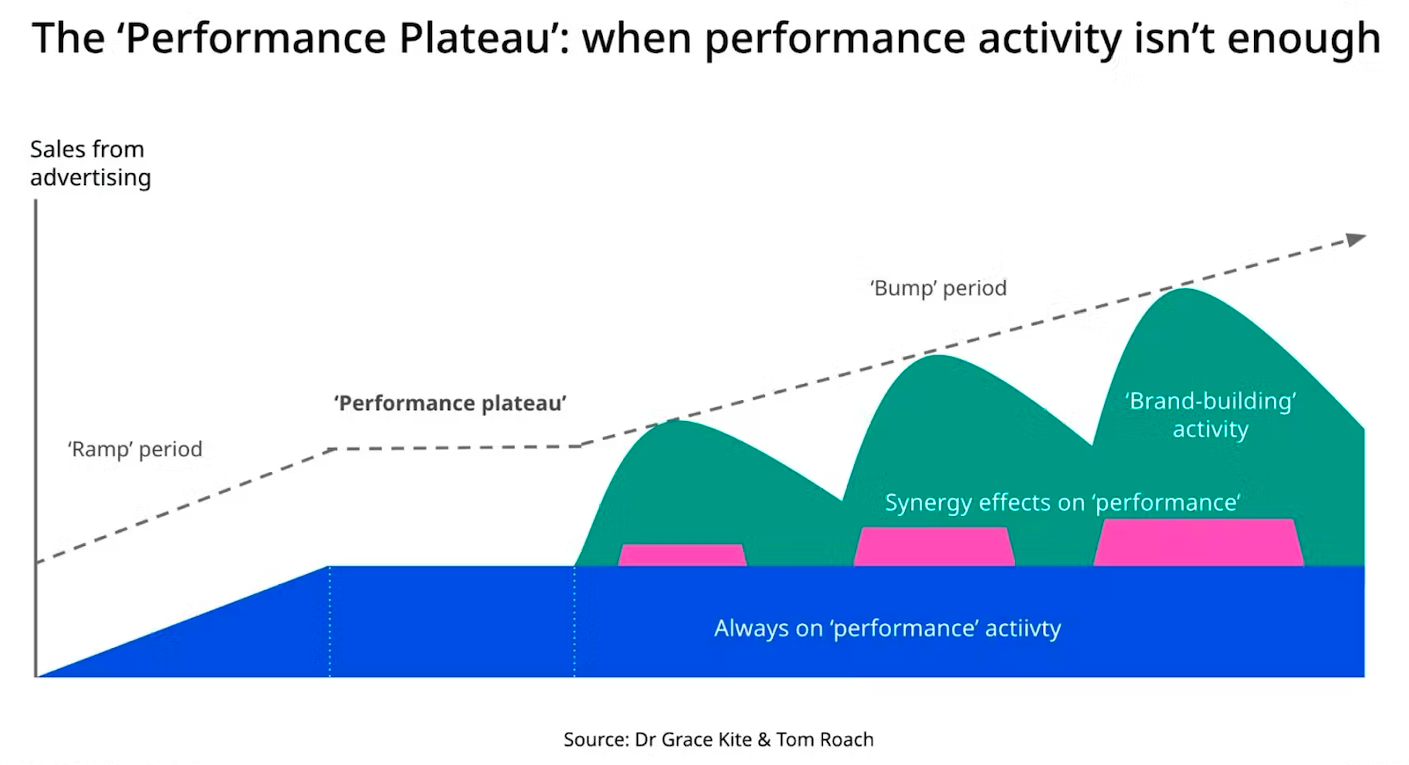The construction of the brand, the “branding”, consists in developing notoriety, positioning the brand, strengthening it, and creating a link with customers and consumers. This work requires a long-term investment, thanks to image campaigns, but also, in particular, by developing its presence on the web and social networks, which requires time.
Performance marketing aims to measure and improve the effectiveness of advertising campaigns using data and analytics tools. Its objective is to effectively direct the levers and advertising creations to generate a formance that the brand is able to measure, thanks to monitoring dashboards. In fact, performance marketing campaigns very often target lead acquisition, traffic generation, or conversions and are limited to short-term marketing actions.
Often, brand strategies and marketing performance levers are separated. In a difficult economic context, the pressure on the shoulders of marketing decision-makers can also lead them to neglect brand investments to focus on performance marketing operations.
However, the strength of the brand in terms of notoriety and image clearly contributes to the performance of tactical marketing actions. Thus, the work of building the brand and the effective use of marketing performance levers are two equally important aspects of marketing and must combine for increasing performance.
Focusing only on short-term indicators can harm the brand
The growing use of digital in marketing makes performance management more and more reliable, fast, and deep. Whether it’s measuring the quality of a site’s audience, monitoring engagement on social networks, the evolution of a site’s referencing or measuring the attribution of different sales levers, the management tools are there: it is enough (almost) to put them in place. This management is even now possible for offline: to measure the contribution of different media to in-store visits, to measure the impact of TV and radio on online conversions (with a solution like Realytics)…
Of course, it is essential that marketing decision-makers exploit the potential of these measurement solutions. In particular, this makes it possible to make short-term arbitrations on campaigns: modify a media mix, change a creative copy, modify a customer journey, personalization or merchandising parameters, etc.
However, it is necessary to take a step back on the short-term steering indicators.
For example, lowering prices or using promotional offers can help generate more leads and conversions, but it is likely that if these levers are used too strongly and too often, it will lead to a deterioration of a company’s image. brand, especially if it claims a premium quality positioning. To increase conversions, AB tests can lead to the conclusion that using more eye-catching visuals or more direct messages is more effective in increasing the volume of clicks: however, is this consistent with the brand’s communication charter? , and does it help to position the brand and build loyalty over time?…
The short term can also lead to the wrong indicator. By focusing on indicators that can be monitored in near real time (clicks, conversions, and possibly customer acquisition), we may be led to neglect the real ROI, based on the real value of the customers acquired. This must be measured over time, because it depends on customer loyalty and the quality of their relationship with the brand. Building the brand, positioning it, also means choosing the right customers for the company.
Finally, by concentrating investments on tactical levers to bring performance in the short term, under the influence of a particular context (economic crisis, new competition, etc.), the risk is to disengage from levers whose effects are feel longer term. This is the case of investments in the reputation of the brand, its image, but also the quality of the relationship with customers, or its “natural” presence on search engines.
The brand is decisive in customer choices
When we consider customer journeys, we also see that a significant part of conversions is played out in brand awareness and image, and therefore in top-of-funnel actions. Why ?
Because when the brand is strong, when its image is positive, consistent with its products and targets, it benefits from obvious advantages over competitors.
- Pricing power
The stronger a brand is, the less sensitive it is to price competition. A recognized brand can compensate for a price difference with a more premium image and the spontaneous perception of greater quality or reliability.
- Spontaneous trust
When clicking to make an appointment, to make a reservation or an order, the confidence that the customer can have in the brand plays a determining role. This client trust is, in order:
- the quality of the expression of the brand (professional, empathetic, etc.)
- to the spontaneous notoriety of the brand (he will favor a brand he knows)
- in the image of the brand, both in terms of quality and adequacy with its values (with equal notoriety)
Thus, the effect of brand awareness can be felt in conversion rates.
- The share of research
Search engines are a vital economic issue. The fact that a brand is spontaneously searched for in Google is directly correlated to its market share. However, to be searched in Google, the brand must first make itself known to its public and benefit from a certain notoriety.
Building a strong brand makes it possible to sustainably increase the effectiveness of performance marketing levers
Acquisition or sales activation campaigns are important for the growth of a business, and especially in its start-up phase. However, as economist Dr. Grace Kite and advertising strategist Tom Roach describe in this article, brands reach a “performance plateau” at some point. That is to say that from a certain level of investment on performance marketing levers (search, display, social, etc.), growth no longer follows, the cost of acquiring new customers increases and the return on advertising investments (ROAS, return on ad spend) decreases. This situation is, according to these two analyses, experienced by 80% of marketing decision-makers, in both the B2C and B2B sectors.
The analysis made by Grace Kite and Tom Roach is that to get out of this situation (or to anticipate it!), it is necessary to balance investments in “branding” (the top of the marketing funnel), and in the levers of acquisition and retention (the bottom of the funnel): in other words, adopting a “full-funnel” approach to communication.
To overcome the effect of the “performance plateau”, Tom Roach gives 5 recommendations:
- Go beyond the orthodoxy of performance marketing, and not rely solely on numbers, by combining different approaches to communication: data and intuition, technology and creativity, art and science, long and short term. In fact, it is a question of combining 2 very distant marketing cultures in general, and this is the most complex phase to create a full-funnel marketing culture.
- Getting to know your “potential” audience: it’s about getting to know not only your existing customers, but also those who don’t buy the brand’s products yet, or hardly ever. Because it is by reaching these people that the brand can generate growth
Increase the size of the audience reached (the “reach”) by broadening the targeting: in fact, 95% of potential buyers are not in demand at a given time (they are not “in-market”). However, they should be reached through communication campaigns, at the “top of the funnel” level, in order to prepare them for purchase when they are in demand. - Build a “performance model” for the brand: if at the start the paid visibility levers (the “paid media”) are important to emerge, it is essential, to make the transition to a sustainable performance model, to develop sales “organic”. That is to say sales linked to the reputation of the brand, to the prescription by current customers, and to the share of voice (natural referencing). By making a transition to a balanced investment between brand communication and performance advertising (in the example given, Gousto, Tom Roach indicates that the balance is 60% on the brand, and 40% on performance), the company guarantees its future sales. Finally, the brand is a “capital”, which should be built up over the long term: “the brand is not a luxury, it is your future cash flows”.
- Choose media capable of generating a positive ROI both in the short and long term: television (TV or catch-up TV) is not the only media capable of meeting branding campaign objectives. On the contrary, many digital media make it possible to meet both branding and performance objectives. The media mix must therefore be thought out for the context of the brand, without preconceptions.
By combining brand campaigns and a performance marketing strategy in parallel, the brand increases the ROI of performance campaigns and generates growth. Tom Roach makes a bicycle analogy: you are no longer able to pedal faster in a lower gear, so you will have to invest more effort in higher gears to start accelerating.

In this video, Grace Kite and Tom Roach explain why they believe branding increases business performance:
As a conclusion…
To achieve sustainable and growing marketing performance, it is necessary to combine branding and performance marketing. The value generated by marketing investments must be considered in the short and long term.
The brand building effort is necessary to maintain the performance of the acquisition levers while generating growth. Acquisition campaigns must be consistent with the identity and positioning of the brand, to preserve it, and to capitalize on its strength.
Meeting short and long-term marketing ROI objectives is the promise of a “full funnel” marketing agency like Dékuple.





